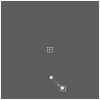Torsional anomalous retinal correspondence effectively expands the visual field in hemianopia
- PMID: 22885782
- PMCID: PMC3429649
- DOI: 10.1097/OPX.0b013e3182678d42
Torsional anomalous retinal correspondence effectively expands the visual field in hemianopia
Abstract
Purpose: Exotropia in congenital homonymous hemianopia has been reported to provide field expansion that is more useful when accompanied with harmonious anomalous retinal correspondence (HARC). Torsional strabismus with HARC provides a similar functional advantage. In a subject with hemianopia demonstrating a field expansion consistent with torsion, we documented torsional strabismus and torsional HARC.
Methods: Monocular visual fields under binocular fixation conditions were plotted using a custom dichoptic visual field perimeter. The dichoptic visual field was also modified to measure perceived visual directions under dissociated and associated conditions across the central 50° diameter field. The field expansion and retinal correspondence of a subject with torsional strabismus (along with exotropia and right hypertropia) with congenital homonymous hemianopia was compared with that of another exotropic subject with acquired homonymous hemianopia without torsion and to a control subject with minimal phoria. Torsional rotations of the eyes were calculated from fundus photographs and perimetry.
Results: Torsional anomalous retinal correspondence documented in the subject with congenital homonymous hemianopia provided a functional binocular field expansion up to 18°. Normal retinal correspondence was mapped for the full 50° visual field in the control subject and for the seeing field of the acquired homonymous hemianopia subject, limiting the functional field expansion benefit.
Conclusions: Torsional strabismus with anomalous retinal correspondence, when occurring with homonymous hemianopia provides useful field expansion in the lower and upper fields. Dichoptic perimetry permits documentation of ocular alignment (lateral, vertical, and torsional) and perceived visual direction under binocular and monocular viewing conditions. Evaluating patients with congenital or early strabismus for HARC is useful when considering surgical correction, particularly in the presence of congenital homonymous hemianopia.
Figures










References
-
- Huber A. Homonymous hemianopia. Neuroophthalmology. 1992;12:351–66.
-
- Zhang X, Kedar S, Lynn MJ, Newman NJ, Biousse V. Homonymous hemianopias: Clinical-anatomic correlations in 904 cases. Neurology. 2006;66:906–10. - PubMed
-
- Bosley TM, Kiyosawa M, Moster M, Harbour R, Zimmerman R, Savino PJ, Sergott RC, Alavi A, Reivich M. Neuro-imaging and positron emission tomography of congenital homonymous hemianopsia. Am J Ophthalmol. 1991;111:413–8. - PubMed
-
- Shinder R, Wolansky L, Turbin RE. Congenital homonymous hemianopia and cortical migration abnormalities in a young adult. J Ped Ophthalmol Strabimus. 2009;46:38–41. - PubMed
-
- Kedar S, Zhang X, Lynn MJ, Newman NJ, Biousse V. Pediatric homonymous hemianopia. J AAOPS. 2006;10:249–52. - PubMed
Publication types
MeSH terms
Grants and funding
LinkOut - more resources
Full Text Sources

